初中英语微格教学教案
- 格式:doc
- 大小:1.50 MB
- 文档页数:7
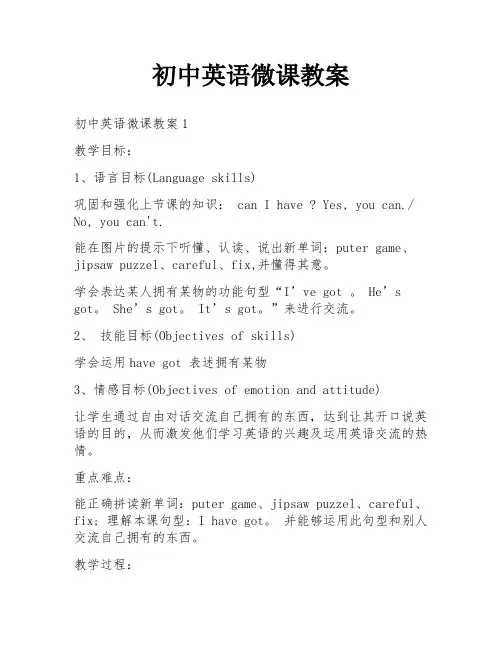
初中英语微课教案初中英语微课教案1教学目标:1、语言目标(Language skills)巩固和强化上节课的知识: can I have ? Yes, you can./ No, you can't.能在图片的提示下听懂、认读、说出新单词:puter game、jipsaw puzzel、careful、fix,并懂得其意。
学会表达某人拥有某物的功能句型“I’ve got 。
He’s got。
She’s got。
It’s got。
”来进行交流。
2、技能目标(Objectives of skills)学会运用have got 表述拥有某物3、情感目标(Objectives of emotion and attitude)让学生通过自由对话交流自己拥有的东西,达到让其开口说英语的目的,从而激发他们学习英语的兴趣及运用英语交流的热情。
重点难点:能正确拼读新单词:puter game、jipsaw puzzel、careful、fix; 理解本课句型:I have got。
并能够运用此句型和别人交流自己拥有的东西。
教学过程:Step1、Warming up:Greeting. T: Hello, boys and girls!S: Hello, teacher!T: How are you, today?S: Fine, thank you.T:What’s the weather like today?S:It’s sunny day.设计意图:以简单轻松的问候进入一个比较愉悦的课堂教学。
Step 2、Lead-in:老师指自己的物品,如课本、衣服等问。
T:what’s this ? S:This is a book;This is a coat.T:This is my book. I’ve got a book. This is my coat. I’ve got a coat. (板书并做动作让学生理解意思I’vegot )让学生运用I’ve got——像老师一样描述自己拥有的东西。
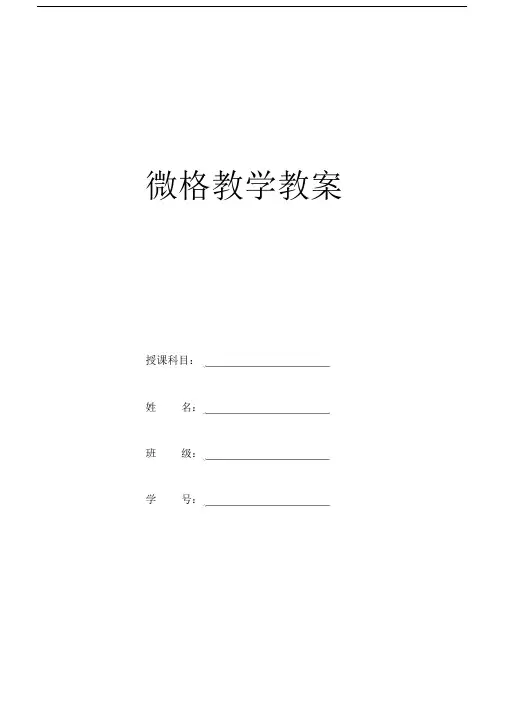
微格教学教案授课科目:姓名:班级:学号:教材课型训练技能教学目标教学方法及手段英语微格教学课时教案执教人:执教日期:人教版八年级上册课题What’s the matter?课时第一课时单词对话讲授教学时间10 分钟合作学习技能知识目标: 1. 学习完成任务所需要的语言:词汇: matter, cold, have a cold, stomachache, sore, back, arm,foot, feet, hand, head, leg, mouth, neck, nose, stomach, tooth,teeth, throat2. 句子准确表达身体的种种不适I have a headache /stomachache/ a toothache.I have a sore neck/a sore arm/ a sore throat/a cold/a fever询问他人身体状况What's the matter?3.完成课本第 7 页教学任务。
能力目标:能够正确描述身体各部位名称,准确表达身体的种种不适,询问他人身体状况情感目标:学会关心他人健康肢体动作与学生互动教学,学生之间互动加强记忆教学过程及内容教学过程教师活动学生活动教案设计说明时间分配T:Hey,boys andgirls! Are you fine?T: Oh! I am so glad tosee you all are soactive and so genetic.S: Yes!以生活事例情All of you are so景导入,调动学healthy. But I am very 1 分钟生上课激情,引sorry that I feel very出学习课题导入tired and there issomething wrong with myback.I may have abackache. Then how do weto ask about others ’health? That is what wewill learn today.Wewill learn a new unit:What’s the matter?( 板出 )T1: Weknow, the back isone part of our body. Sofirst, can you give me S1: headsome other names of the noseparts of body?face( 根据学生的作答及充throat板出一的 )teethT2:Follow me together arm由学生以旧to read these words.stomach引出新T3:OK. Now I ask, you neck,以学生中answer.foot心What ’ s this? ( 手依⋯次指着自己的身体部S2: 跟学位,学生作答 )S3:学生作答 4 分T3: And then we will usethese words to expressthe health problems与学生互( 板出相关元)合作学,加Follow me together.,活堂跟气氛Headache/backache/toothache/stomachache/ ⋯S4:猜T4: 用肢体言做出各种身体不适状,学生用所学做出猜S5: 完成T5:完成本第七1a部分,核答案T1:OK, good! Then howdo we ask aboutothers ’ health? It isour title: what’s thematter? (板 )How to response?I have a headache/跟句型学backache/toothache/引新stomachache/ ⋯( 板 ) 4 分答至熟T2:now ,please closeyour book. It’s pairwork time. You will bedivided into some groups. Every two of you will be one group.One asks, the other one answers to make up a dialogue with theexpressions we have学生互动,合作 learned. I will give学生自主编组对话互 学习,启发学生 you 5 minutes and then 动,熟练句型 主动思考,加深 one group of you will 印象act it out in front ofthe class.Time is up!学生上台表演点评Well done! I think you have been familiar with these expressions. And I hope that you willreview it after class.结 课What ’s more, I hope发出希望,及时 分钟all of you can learn to1复习,学以致用care about others.Asking he “ what ’ s the matter ” when we see someone is not feeling very well. Thank you!在本次授课中, 导入环节以身边的亲身事例开始, 与学生互动,授课内容主要采取合作学习的教学技能让学生在互动中学习词汇, 操练句型,已达到加深印教学反思 象,迅速有效的熟悉强化所学知识,并得以运用生活。
![初中英语微格教学教案[1]](https://uimg.taocdn.com/8290e6810d22590102020740be1e650e52eacf83.webp)
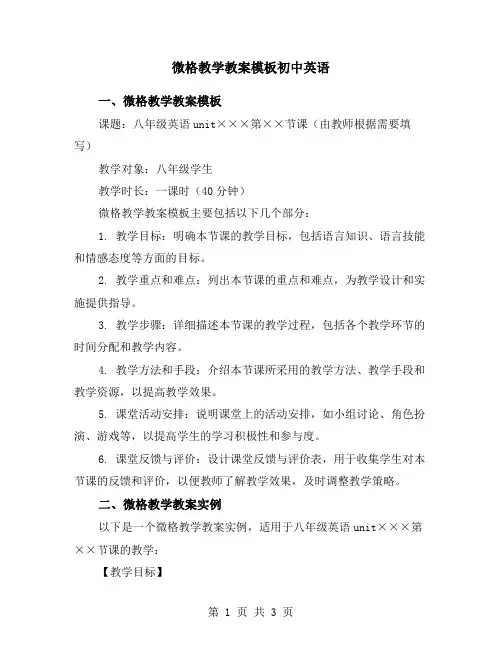
微格教学教案模板初中英语一、微格教学教案模板课题:八年级英语unit×××第××节课(由教师根据需要填写)教学对象:八年级学生教学时长:一课时(40分钟)微格教学教案模板主要包括以下几个部分:1. 教学目标:明确本节课的教学目标,包括语言知识、语言技能和情感态度等方面的目标。
2. 教学重点和难点:列出本节课的重点和难点,为教学设计和实施提供指导。
3. 教学步骤:详细描述本节课的教学过程,包括各个教学环节的时间分配和教学内容。
4. 教学方法和手段:介绍本节课所采用的教学方法、教学手段和教学资源,以提高教学效果。
5. 课堂活动安排:说明课堂上的活动安排,如小组讨论、角色扮演、游戏等,以提高学生的学习积极性和参与度。
6. 课堂反馈与评价:设计课堂反馈与评价表,用于收集学生对本节课的反馈和评价,以便教师了解教学效果,及时调整教学策略。
二、微格教学教案实例以下是一个微格教学教案实例,适用于八年级英语unit×××第××节课的教学:【教学目标】1. 学生能够掌握本单元的重点单词和短语。
2. 学生能够运用所学句型进行简单的对话和交流。
3. 培养学生学习英语的兴趣和自信心。
【教学重点和难点】1. 重点:学生能够掌握本单元的单词和短语,能够运用所学句型进行简单的对话和交流。
2. 难点:学生能够灵活运用所学知识,表达自己的思想和情感。
【教学方法和手段】1. 采用多媒体教学,通过图片、视频等资源激发学生的学习兴趣。
2. 通过角色扮演、小组讨论等课堂活动,提高学生的参与度和学习效果。
3. 使用录音机进行听力训练,帮助学生提高听力水平。
【课堂活动安排】1. 热身活动(5分钟):进行小组讨论,让学生用所学句型进行简单的对话交流,为新课做准备。
2. 新课导入(5分钟):教师通过图片、视频等资源,引导学生进入新课内容。
3. 新课讲解(15分钟):教师详细讲解本单元的单词和短语,学生跟读、记忆。
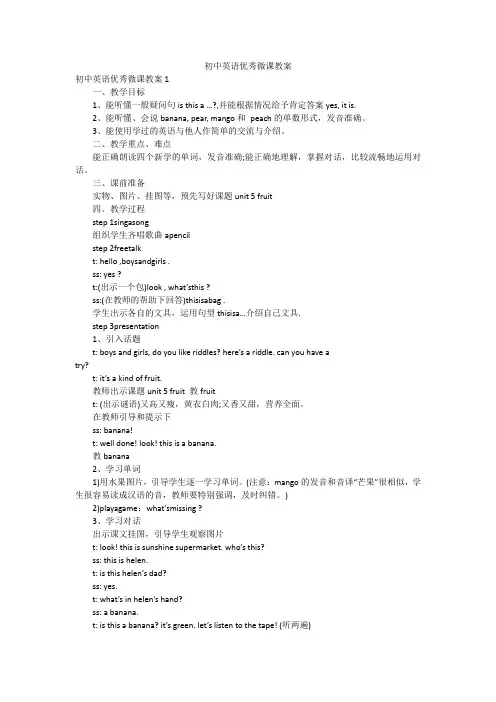
初中英语优秀微课教案初中英语优秀微课教案1一、教学目标1、能听懂一般疑问句is this a …?,并能根据情况给予肯定答案yes, it is.2、能听懂、会说banana, pear, mango和peach的单数形式,发音准确。
3、能使用学过的英语与他人作简单的交流与介绍。
二、教学重点、难点能正确朗读四个新学的单词,发音准确;能正确地理解,掌握对话,比较流畅地运用对话。
三、课前准备实物、图片、挂图等,预先写好课题unit 5 fruit四、教学过程step 1singasong组织学生齐唱歌曲apencilstep 2freetalkt: hello ,boysandgirls .ss: yes ?t:(出示一个包)look , what’sthis ?ss:(在教师的帮助下回答)thisisabag .学生出示各自的文具,运用句型thisisa…介绍自己文具.step 3presentation1、引入话题t: boys and girls, do you like riddles? here’s a riddle. can you have atry?t: it’s a kind of fruit.教师出示课题unit 5 fruit 教fruitt: (出示谜语)又高又瘦,黄衣白肉;又香又甜,营养全面。
在教师引导和提示下ss: banana!t: well done! look! this is a banana.教banana2、学习单词1)用水果图片,引导学生逐一学习单词。
(注意:mango的发音和音译“芒果”很相似,学生很容易读成汉语的音,教师要特别强调,及时纠错。
)2)playagame:what’smissing ?3、学习对话出示课文挂图,引导学生观察图片t: look! this is sunshine supermarket. who’s this?ss: this is helen.t: is this helen’s dad?ss: yes.t: what’s in helen’s hand?ss: a banana.t: is this a banana? it’s green. let’s listen to the tape! (听两遍)t: is this a banana?ss: yes, it is.t: you are right. now, let’s read after the tape.step 4practice1)听录音,朗读课文。
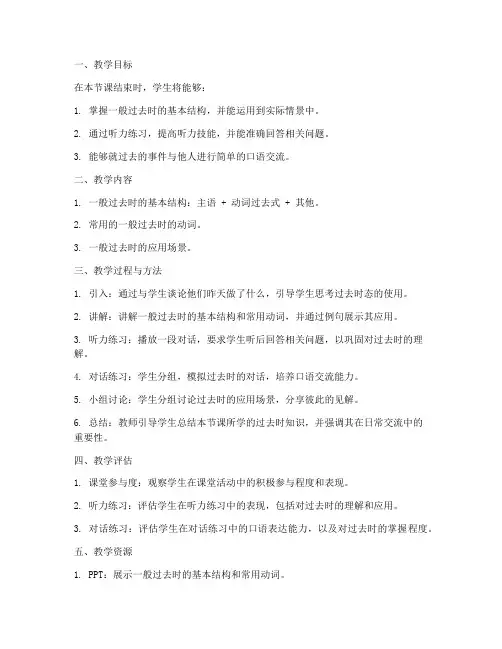
一、教学目标在本节课结束时,学生将能够:1. 掌握一般过去时的基本结构,并能运用到实际情景中。
2. 通过听力练习,提高听力技能,并能准确回答相关问题。
3. 能够就过去的事件与他人进行简单的口语交流。
二、教学内容1. 一般过去时的基本结构:主语 + 动词过去式 + 其他。
2. 常用的一般过去时的动词。
3. 一般过去时的应用场景。
三、教学过程与方法1. 引入:通过与学生谈论他们昨天做了什么,引导学生思考过去时态的使用。
2. 讲解:讲解一般过去时的基本结构和常用动词,并通过例句展示其应用。
3. 听力练习:播放一段对话,要求学生听后回答相关问题,以巩固对过去时的理解。
4. 对话练习:学生分组,模拟过去时的对话,培养口语交流能力。
5. 小组讨论:学生分组讨论过去时的应用场景,分享彼此的见解。
6. 总结:教师引导学生总结本节课所学的过去时知识,并强调其在日常交流中的重要性。
四、教学评估1. 课堂参与度:观察学生在课堂活动中的积极参与程度和表现。
2. 听力练习:评估学生在听力练习中的表现,包括对过去时的理解和应用。
3. 对话练习:评估学生在对话练习中的口语表达能力,以及对过去时的掌握程度。
五、教学资源1. PPT:展示一般过去时的基本结构和常用动词。
2. 对话录音:用于听力练习。
3. 小组讨论:提供学生互相交流和分享的平台。
六、教学建议1. 针对不同学生的学习水平,可以适当调整教学内容和难度。
2. 在教学过程中,注意引导学生主动参与,提高他们的学习兴趣。
3. 鼓励学生在课堂活动中积极提问,帮助解决学习中的困惑。
4. 针对学生的反馈,及时调整教学方法和节奏,确保教学效果。
通过以上教学设计,希望能够帮助学生掌握一般过去时的基本知识和应用,提高他们的英语听说能力,为今后的学习打下坚实的基础。
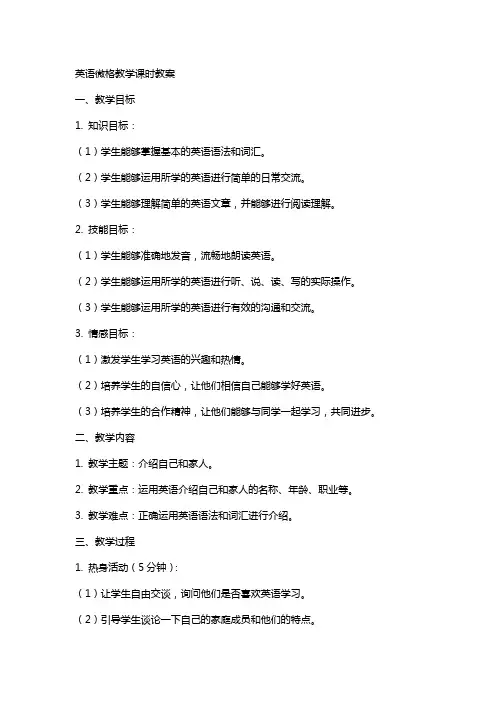
英语微格教学课时教案一、教学目标1. 知识目标:(1)学生能够掌握基本的英语语法和词汇。
(2)学生能够运用所学的英语进行简单的日常交流。
(3)学生能够理解简单的英语文章,并能够进行阅读理解。
2. 技能目标:(1)学生能够准确地发音,流畅地朗读英语。
(2)学生能够运用所学的英语进行听、说、读、写的实际操作。
(3)学生能够运用所学的英语进行有效的沟通和交流。
3. 情感目标:(1)激发学生学习英语的兴趣和热情。
(2)培养学生的自信心,让他们相信自己能够学好英语。
(3)培养学生的合作精神,让他们能够与同学一起学习,共同进步。
二、教学内容1. 教学主题:介绍自己和家人。
2. 教学重点:运用英语介绍自己和家人的名称、年龄、职业等。
3. 教学难点:正确运用英语语法和词汇进行介绍。
三、教学过程1. 热身活动(5分钟):(1)让学生自由交谈,询问他们是否喜欢英语学习。
(2)引导学生谈论一下自己的家庭成员和他们的特点。
2. 引入新课(10分钟):(1)向学生介绍本节课的主题:介绍自己和家人。
(2)展示一些与家庭成员相关的图片,让学生猜测他们的关系。
3. 讲解和示范(10分钟):(1)讲解如何用英语介绍自己和家人的名称、年龄、职业等。
(2)示范如何用英语进行自我介绍和介绍家人。
4. 实践环节(10分钟):(1)让学生分成小组,用英语进行自我介绍和介绍家人。
(2)鼓励学生大胆开口,注重语音语调的准确性。
5. 巩固环节(5分钟):(1)让学生在班级内进行角色扮演,模拟真实场景进行自我介绍和介绍家人。
(2)邀请部分学生到讲台前进行表演,给予表扬和鼓励。
四、作业布置1. 让学生用英语写一篇关于自己和家人的介绍短文。
2. 让学生复习本节课所学的词汇和语法,准备下一节课的测试。
五、教学反思2. 对教学方法和教学内容进行反思,看是否需要进行调整。
3. 思考如何激发学生的学习兴趣,提高他们的学习积极性。
六、教学评估1. 课堂观察:观察学生在课堂上的参与程度、发音准确性以及语言流畅性。
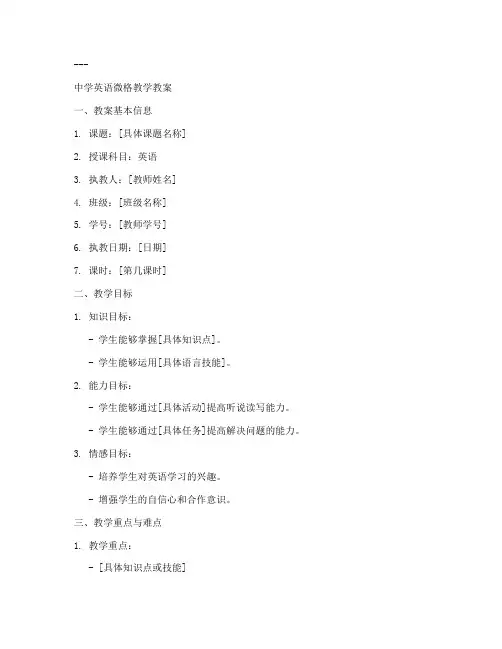
---中学英语微格教学教案一、教案基本信息1. 课题:[具体课题名称]2. 授课科目:英语3. 执教人:[教师姓名]4. 班级:[班级名称]5. 学号:[教师学号]6. 执教日期:[日期]7. 课时:[第几课时]二、教学目标1. 知识目标:- 学生能够掌握[具体知识点]。
- 学生能够运用[具体语言技能]。
2. 能力目标:- 学生能够通过[具体活动]提高听说读写能力。
- 学生能够通过[具体任务]提高解决问题的能力。
3. 情感目标:- 培养学生对英语学习的兴趣。
- 增强学生的自信心和合作意识。
三、教学重点与难点1. 教学重点:- [具体知识点或技能]2. 教学难点:- [具体知识点或技能]四、教学过程1. 导入新课- [导入方法,如:提问、游戏、图片展示等] - [导入时间]2. 讲授新课- [教学内容,按照教学目标进行分解]- [教学方法,如:讲解、演示、讨论等]- [教学时间]3. 操练技能- [具体操练活动,如:角色扮演、小组讨论等] - [操练时间]4. 巩固练习- [练习内容,如:完成练习题、口头表达等] - [练习时间]5. 课堂活动- [具体活动内容,如:小组竞赛、辩论等]- [活动时间]6. 归纳小结- [对本节课内容的总结,强调重点和难点]- [时间]7. 作业布置- [布置作业的内容和目的]- [作业要求]五、板书设计1. 板书标题:[课题名称]2. 板书内容:- [按教学过程分点列出重点内容]六、教具准备1. 多媒体设备:[如电脑、投影仪等]2. 实物教具:[如图片、卡片等]3. 教学软件:[如PPT、教学软件等]七、教学反思1. 教学效果评估:- 学生对知识的掌握情况- 学生能力的提高情况- 学生情感的体验情况2. 教学改进措施:- 针对教学过程中出现的问题,提出改进方案- 对教学方法、教学内容进行调整---请注意,这个模板仅供参考,实际教案的编写需要根据具体的教学内容、学生情况和教学目标进行详细设计和调整。
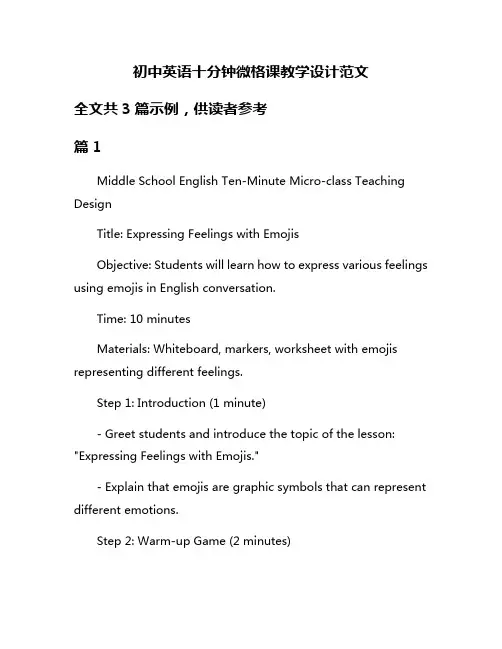
初中英语十分钟微格课教学设计范文全文共3篇示例,供读者参考篇1Middle School English Ten-Minute Micro-class Teaching DesignTitle: Expressing Feelings with EmojisObjective: Students will learn how to express various feelings using emojis in English conversation.Time: 10 minutesMaterials: Whiteboard, markers, worksheet with emojis representing different feelings.Step 1: Introduction (1 minute)- Greet students and introduce the topic of the lesson: "Expressing Feelings with Emojis."- Explain that emojis are graphic symbols that can represent different emotions.Step 2: Warm-up Game (2 minutes)- Divide the class into small groups and give each group a worksheet with emojis representing various feelings.- Ask students to match the emojis with the correct feelings in English.- Encourage students to work together and discuss their answers within their groups.Step 3: Presentation (3 minutes)- Write some common feeling words on the whiteboard, such as happy, sad, angry, and surprised.- Show students how to use emojis to express these feelings in a sentence, for example: "I am happy ", "She is sad ."- Ask students to practice saying the sentences out loud.Step 4: Practice (3 minutes)- Divide the class into pairs and ask students to take turns expressing different feelings using emojis in short conversations.- Monitor the students and provide feedback on their pronunciation and use of emojis.- Encourage students to be creative and use different emojis to express the same feeling.Step 5: Wrap-up (1 minute)- Ask students to share some of the conversations they had with their partners.- Review the lesson by asking students how they can use emojis to express their feelings in English conversation.- Thank the students for their participation and end the class with a positive message.This ten-minute micro-class is designed to help students practice expressing feelings using emojis in English conversation. By engaging in interactive activities and practicing with their peers, students will improve their speaking skills and learn new ways to communicate emotions effectively.篇2Middle School English Ten-Minute Micro-class Teaching DesignI. Topic: My Favorite BookII. Teaching Objectives:1. Students will be able to talk about their favorite books in English.2. Students will be able to use adjectives to describe the characters and plot of a book.3. Students will be able to engage in discussions with their classmates about books.III. Teaching Procedures:1. Greeting (1 minute)- The teacher greets the students and asks them how they are doing.2. Warm-up (2 minutes)- The teacher shows a picture of a book cover and asks the students to guess the title of the book.- The teacher elicits responses from the students and asks them to explain why they think it is that particular book.3. Presentation (3 minutes)- The teacher introduces the topic of the lesson: "My Favorite Book."- The teacher asks the students to think about their favorite book and why they like it.- The teacher models how to talk about their favorite book using adjectives to describe the characters and plot.4. Practice (3 minutes)- The teacher divides the students into pairs.- The students take turns talking about their favorite book to their partner, using the adjectives they learned in the presentation.- The teacher circulates and listens to the students, providing feedback and correction as needed.5. Extension (1 minute)- The teacher asks a few students to share their favorite book with the class.- The class engages in a discussion, asking questions and sharing their opinions about the books.IV. Conclusion (1 minute)- The teacher summarizes the key points of the lesson and praises the students for their participation and hard work.V. Homework (1 minute)- The teacher assigns homework for the students to write a short paragraph about their favorite book, using the adjectives they learned in class.VI. Evaluation:- The teacher assesses the students' performance based on their participation in the discussion and their ability to use adjectives to describe their favorite book.By following this teaching design, students will not only improve their English speaking and listening skills but also develop a love for reading and sharing their favorite books with their classmates.篇3Middle School English Ten Minutes Micro Classroom Teaching DesignContent: WeatherTime: 10 minutesTeaching Objectives:1. Students will be able to learn 8 weather-related vocabulary words.2. Students will be able to use the vocabulary words to describe the weather.3. Students will be able to understand simple weather sentences.Teaching Procedures:1. Warm-up (1 minute)Greet the students and ask them about the weather outside. Use gestures or pictures to help them understand the question if necessary.2. Vocabulary Introduction (2 minutes)Introduce 8 new weather-related vocabulary words: sunny, rainy, windy, cloudy, snowy, foggy, hot, cold. Show pictures or use gestures to help students understand each word. Say each word clearly and have students repeat after you.3. Vocabulary Practice (2 minutes)Show pictures of different weather conditions and ask students to say the corresponding vocabulary word. Repeat several times until the students can accurately identify each weather condition.4. Sentence Building (3 minutes)Model a simple weather sentence using the vocabulary words, such as "It is sunny today." Have students repeat the sentence together. Then, ask students to create their own weather sentences using the vocabulary words. Provide guidance and corrections as needed.5. Review and Evaluation (2 minutes)Review the new vocabulary words and weather sentences with students. Ask individual students to make a weather sentence using the vocabulary words. Provide feedback and praise for efforts.6. Summary and Closure (1 minute)Summarize the lesson by reviewing the key points and vocabulary words. Encourage students to practice describing the weather in English both in class and outside of class. Dismiss the students with a goodbye and a reminder to pay attention to the weather.Teaching Aids:- Pictures of different weather conditions- Flashcards with the vocabulary words- Gestures to help illustrate the meaning of the wordsAssessment:Observation of students' participation in vocabulary practice and sentence building activities. Check students' understanding and correct any mistakes made during the lesson.Extension:Encourage students to keep a weather journal where they can practice writing about the weather each day using the new vocabulary words. Discuss different weather phenomena around the world to broaden students' knowledge and understanding of weather.。
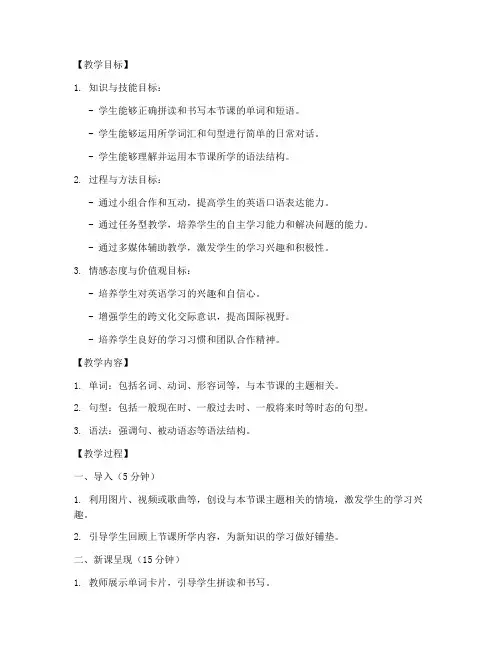
【教学目标】1. 知识与技能目标:- 学生能够正确拼读和书写本节课的单词和短语。
- 学生能够运用所学词汇和句型进行简单的日常对话。
- 学生能够理解并运用本节课所学的语法结构。
2. 过程与方法目标:- 通过小组合作和互动,提高学生的英语口语表达能力。
- 通过任务型教学,培养学生的自主学习能力和解决问题的能力。
- 通过多媒体辅助教学,激发学生的学习兴趣和积极性。
3. 情感态度与价值观目标:- 培养学生对英语学习的兴趣和自信心。
- 增强学生的跨文化交际意识,提高国际视野。
- 培养学生良好的学习习惯和团队合作精神。
【教学内容】1. 单词:包括名词、动词、形容词等,与本节课的主题相关。
2. 句型:包括一般现在时、一般过去时、一般将来时等时态的句型。
3. 语法:强调句、被动语态等语法结构。
【教学过程】一、导入(5分钟)1. 利用图片、视频或歌曲等,创设与本节课主题相关的情境,激发学生的学习兴趣。
2. 引导学生回顾上节课所学内容,为新知识的学习做好铺垫。
二、新课呈现(15分钟)1. 教师展示单词卡片,引导学生拼读和书写。
2. 通过例句和情景对话,讲解句型和语法知识。
3. 利用多媒体展示相关图片和视频,帮助学生理解和记忆。
三、巩固练习(10分钟)1. 小组合作,进行单词接龙、句子改写等游戏活动,巩固所学知识。
2. 学生根据教师提供的情景,运用所学句型和语法进行角色扮演。
四、拓展活动(10分钟)1. 教师提供一篇与主题相关的短文,引导学生阅读并回答问题。
2. 学生进行小组讨论,分享自己对文章的理解和感悟。
五、总结与反思(5分钟)1. 教师对本节课所学内容进行总结,强调重点和难点。
2. 学生回顾本节课所学知识,分享自己的学习心得。
【教学评价】一、课堂表现评价1. 学生参与课堂活动的积极性。
2. 学生在小组合作中的表现。
3. 学生对知识的掌握程度。
二、课后作业评价1. 学生完成课后作业的质量。
2. 学生对课后作业的完成情况。
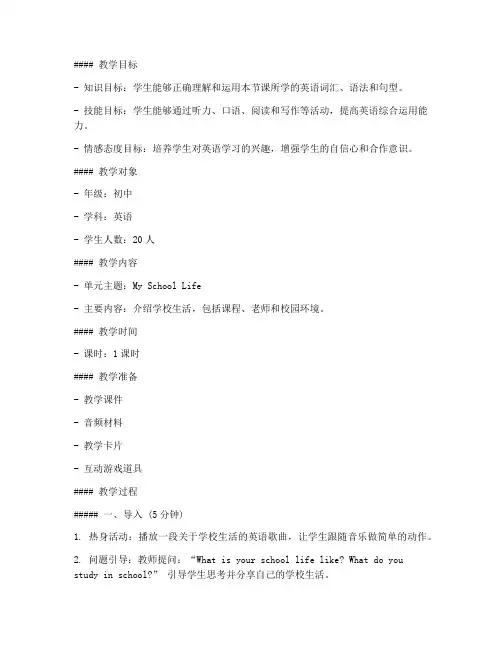
#### 教学目标- 知识目标:学生能够正确理解和运用本节课所学的英语词汇、语法和句型。
- 技能目标:学生能够通过听力、口语、阅读和写作等活动,提高英语综合运用能力。
- 情感态度目标:培养学生对英语学习的兴趣,增强学生的自信心和合作意识。
#### 教学对象- 年级:初中- 学科:英语- 学生人数:20人#### 教学内容- 单元主题:My School Life- 主要内容:介绍学校生活,包括课程、老师和校园环境。
#### 教学时间- 课时:1课时#### 教学准备- 教学课件- 音频材料- 教学卡片- 互动游戏道具#### 教学过程##### 一、导入 (5分钟)1. 热身活动:播放一段关于学校生活的英语歌曲,让学生跟随音乐做简单的动作。
2. 问题引导:教师提问:“What is your school life like? What do youstudy in school?” 引导学生思考并分享自己的学校生活。
##### 二、新课讲解 (15分钟)1. 词汇教学:展示与学校生活相关的词汇,如:class, teacher, library, playground等,通过图片或实物展示帮助学生记忆。
2. 语法讲解:讲解一般现在时态,通过例句和练习帮助学生理解和使用。
3. 句型练习:通过小组讨论和角色扮演,让学生运用所学词汇和句型进行交流。
##### 三、活动环节 (20分钟)1. 听力练习:播放一段关于学校生活的英语对话,让学生听后回答问题,如:“What is the girl talking about?”2. 阅读理解:分发一篇关于学校生活的短文,让学生阅读并回答问题,如:“What is the school like?”3. 写作练习:让学生用所学词汇和句型写一段关于自己学校生活的短文。
##### 四、巩固练习 (10分钟)1. 游戏环节:组织一个与学校生活相关的游戏,如“Guess the Word”或“Find the Mistake”,提高学生的参与度和学习兴趣。
一、课程基本信息课程名称:初中英语授课年级:八年级授课班级:八年级(1)班授课时间:40分钟教学目标:1. 知识目标:学生能够掌握本节课的重点词汇和句型。
2. 技能目标:提高学生的听说能力和口语表达能力。
3. 情感态度目标:激发学生学习英语的兴趣,培养学生的跨文化交际意识。
二、教学重难点1. 教学重点:正确运用本节课的词汇和句型进行日常对话。
2. 教学难点:灵活运用所学词汇和句型,在真实情境中进行交流。
三、教学过程(一)导入(5分钟)1. 利用多媒体展示与课程主题相关的图片或视频,激发学生的学习兴趣。
2. 通过简单的英语问答,复习上节课所学内容,引导学生进入英语学习的氛围。
(二)新课讲解(15分钟)1. 词汇教学:- 展示新词汇,引导学生通过图片、语境等方式理解词汇含义。
- 通过例句讲解词汇的用法,让学生学会在句子中运用新词汇。
- 进行词汇拼写练习,巩固学生对新词汇的记忆。
2. 句型教学:- 通过情景模拟,展示句型的实际运用。
- 引导学生进行句型练习,提高口语表达能力。
(三)课堂活动(15分钟)1. 小组讨论:- 将学生分成若干小组,围绕本节课的主题进行讨论。
- 小组内互相交流,培养学生的合作意识和口语表达能力。
2. 角色扮演:- 学生根据所学内容,分组进行角色扮演。
- 通过角色扮演,让学生在真实的情境中运用所学知识。
(四)巩固练习(5分钟)1. 听写练习:- 教师播放录音,学生进行听写练习,巩固本节课所学词汇和句型。
2. 口头表达:- 学生根据所学内容,进行口头表达练习,教师给予点评和指导。
四、作业布置1. 复习本节课所学词汇和句型。
2. 预习下节课内容。
五、教学反思1. 教学过程中,关注学生的个体差异,因材施教。
2. 创设真实情境,提高学生的实际运用能力。
3. 鼓励学生积极参与课堂活动,提高学习兴趣。
六、教学资源1. 多媒体课件2. 录音材料3. 图片和视频素材七、板书设计1. 词汇:重点词汇及例句2. 句型:重点句型及用法3. 情境:角色扮演场景八、注意事项1. 教师要注意语速和语调,确保学生能够听懂。
英语微格教学课时教案一、教学目标1. 知识目标:让学生掌握基本的英语语法、词汇和句型。
2. 能力目标:提高学生的英语口语表达能力和听力理解能力。
二、教学内容1. 词汇:常见的日常词汇,如问候、介绍、道别等。
2. 语法:基本句型结构,如主谓宾、主系表等。
3. 句型:日常交流中的常用句型,如询问时间、地点、喜好等。
三、教学重点与难点1. 重点:词汇的掌握和运用,基本句型的构建。
2. 难点:语法知识的运用,口语表达的流畅性。
四、教学方法1. 任务型教学法:通过设定具体任务,让学生在完成任务的过程中练习英语。
2. 交际法:模拟真实场景,让学生在实际交流中提高英语水平。
五、教学步骤1. 热身活动(5分钟):教师与学生用中文进行简单的问候,引入英语问候的话题。
2. 新课导入(10分钟):教师介绍本节课的词汇和语法知识,通过示例让学生理解并掌握。
3. 课堂实践(15分钟):学生分组进行角色扮演,运用所学词汇和句型进行交流。
4. 听力练习(10分钟):教师播放英语对话或短文,学生进行听力理解,回答相关问题。
5. 总结与作业布置(5分钟):教师对本节课的内容进行总结,布置作业,鼓励学生复习巩固所学知识。
六、教学评价1. 评价方式:课堂表现、作业完成情况、听力测试成绩。
2. 评价标准:学生能够流利地使用所学词汇和句型进行交流,作业正确率达到要求,听力测试成绩良好。
七、教学资源1. 教材:英语微格教学教材。
2. 辅助材料:单词卡片、听力材料、角色扮演道具等。
八、教学进度安排1. 第1周:基本问候和介绍。
2. 第2周:询问时间和地点。
3. 第3周:表达喜好和兴趣。
4. 第4周:谈论日常活动。
5. 第5周:复习和总结。
九、教学反思1. 教师需要在课后对教学效果进行反思,总结教学中的优点和不足。
2. 根据学生的反馈和学习情况,调整教学方法和进度。
十、拓展活动1. 组织英语角活动,让学生在轻松的氛围中练习英语。
2. 开展英语演讲比赛,提高学生的英语表达能力。
一、课程名称初中英语微格课二、教学目标1. 通过微格课,帮助学生巩固和复习已学英语知识,提高英语实际应用能力。
2. 培养学生的英语听说能力,提高学生的口语表达流利度。
3. 增强学生对英语学习的兴趣,激发学生的学习积极性。
三、教学内容1. 主题:根据实际教学需要,选取适合的英语话题。
2. 教学材料:教材、图片、音频、视频等。
四、教学过程(一)导入(5分钟)1. 利用图片、音频或视频导入主题,激发学生的学习兴趣。
2. 简要介绍本次微格课的学习目标。
(二)热身活动(10分钟)1. 进行简单的英语歌曲或游戏,活跃课堂气氛。
2. 引导学生进行英语口语练习,为接下来的教学环节做准备。
(三)主体教学(25分钟)1. 阅读教材,引导学生关注重点词汇和句型。
2. 分析课文内容,讲解重点语法知识。
3. 进行听力练习,提高学生的听力水平。
4. 分组讨论,让学生运用所学知识进行交流。
5. 角色扮演,锻炼学生的口语表达能力。
(四)巩固练习(10分钟)1. 进行课后练习,巩固所学知识。
2. 教师巡回指导,解答学生在练习过程中遇到的问题。
(五)总结与反馈(5分钟)1. 对本次微格课进行总结,强调重点知识。
2. 鼓励学生在课后继续复习巩固。
3. 收集学生对本次微格课的反馈意见,为今后的教学提供参考。
五、教学评价1. 课堂参与度:观察学生在课堂上的表现,如是否积极参与、回答问题等。
2. 口语表达能力:评估学生在角色扮演和小组讨论中的口语表达流利度。
3. 作业完成情况:检查学生课后练习的完成情况。
六、教学反思1. 教师应根据学生的实际情况,调整教学内容和教学方法。
2. 注重培养学生的英语实际应用能力,提高学生的英语综合素质。
3. 加强与学生之间的互动,关注学生的学习需求,提高教学效果。
七、教学资源1. 教材:初中英语教材2. 图片、音频、视频:与教学内容相关的素材3. 课后练习:课后巩固练习题八、教学时间1. 微格课总时长:40分钟2. 各环节时间分配:导入(5分钟)、热身活动(10分钟)、主体教学(25分钟)、巩固练习(10分钟)、总结与反馈(5分钟)以上为初中英语微格课教案模板,教师可根据实际教学情况进行调整和优化。
课时:1课时年级:八年级教材:《英语课程标准》教学目标:1. 学生能够正确朗读并理解单词:book, school, teacher, student。
2. 学生能够运用所学单词进行简单的对话。
3. 培养学生的听说能力,提高英语学习的兴趣。
教学重点:1. 正确朗读单词。
2. 理解单词的含义。
3. 进行简单的对话。
教学难点:1. 单词的正确发音。
2. 对话中的语法运用。
教学准备:1. 多媒体课件(包含单词图片、例句等)。
2. 教学卡片(单词卡片)。
3. 课堂练习册。
教学过程:一、导入(1分钟)1. 教师与学生用英语进行简单的问候。
2. 引导学生回忆已学过的单词,如:hello, good morning, thank you等。
二、单词学习(3分钟)1. 教师展示单词卡片,引导学生朗读并理解单词的含义。
2. 学生跟读,教师纠正发音。
3. 教师播放例句,学生跟读并理解例句的意思。
三、对话练习(3分钟)1. 教师展示对话情景,引导学生运用所学单词进行对话。
2. 学生分组练习,教师巡视指导。
3. 学生展示对话,教师点评并纠正错误。
四、课堂练习(2分钟)1. 教师发放课堂练习册,学生独立完成练习。
2. 教师巡视指导,解答学生疑问。
五、总结(1分钟)1. 教师引导学生回顾本节课所学内容。
2. 学生用英语总结所学单词和对话。
教学反思:本节课通过微格教学,使学生在短时间内掌握了单词和对话,提高了英语学习的兴趣。
在教学过程中,教师要注意以下几点:1. 注重学生的发音,及时纠正错误。
2. 创设真实的语言环境,提高学生的听说能力。
3. 鼓励学生积极参与课堂活动,提高课堂氛围。
4. 及时总结教学效果,调整教学策略。
教学评价:1. 学生能够正确朗读并理解单词:book, school, teacher, student。
2. 学生能够运用所学单词进行简单的对话。
3. 学生在课堂上的参与度较高,学习兴趣浓厚。
备注:1. 教师可根据实际情况调整教学内容和教学时间。
一、教学目标1. 知识目标:- 学生能够掌握本节课的英语单词和短语。
- 学生能够理解并运用本节课的语法结构。
- 学生能够通过听、说、读、写等技能提高英语水平。
2. 能力目标:- 学生能够运用所学知识进行简单的日常交流。
- 学生能够通过合作学习提高团队合作能力。
- 学生能够通过自我评价和同伴评价提高自主学习能力。
3. 情感态度目标:- 学生能够培养对英语学习的兴趣和自信心。
- 学生能够树立跨文化交流的意识。
二、教学内容1. 单元主题:本节课的主题为“学校生活”。
2. 教学内容:- 单词:school, class, teacher, student, desk, chair, book, computer, etc.- 语法:一般现在时态,表示经常性动作或状态。
- 日常交流:询问和回答关于学校生活的相关问题。
三、教学重难点1. 教学重点:- 单词和短语的掌握。
- 语法结构的运用。
- 日常交流的实践。
2. 教学难点:- 学生对语法结构的理解和运用。
- 学生在交流中的语言表达和听力理解。
四、教学过程1. 导入新课- 利用图片、视频等引入本节课的主题,激发学生的学习兴趣。
2. 新课讲解- 教师讲解单词、短语和语法结构,结合实际语境进行示范。
- 学生跟读,巩固所学知识。
3. 练习环节- 学生进行听力练习,听懂并回答相关问题。
- 学生进行口语练习,运用所学知识进行日常交流。
4. 小组合作- 学生分组进行角色扮演,模拟学校生活场景,提高口语表达能力。
- 学生互相评价,共同进步。
5. 课堂小结- 教师总结本节课所学内容,强调重点和难点。
- 学生回顾所学知识,巩固记忆。
6. 作业布置- 布置课后作业,包括单词记忆、语法练习和口语练习。
五、教学评价1. 课堂表现评价:- 学生参与课堂活动的积极性。
- 学生在口语练习中的表现。
2. 作业评价:- 学生对单词、短语和语法结构的掌握程度。
- 学生在口语练习中的语言表达和听力理解能力。
英语微格课教案模板(共7篇)第1篇:英语微格课教案一.教学目标(一)知识与技能目标:1.学生能够听、说、读出4个关于动物单词的短语:(a beautiful bird、a naughty monkey、a strong tiger、a big elephant)。
2.学生能够运用句型:Look at this/that…It’s… 向朋友简单地描述动物的特征。
(二)过程与方法目标:1.教师通过自编歌曲完整地向学生介绍动物园里的4个小动物:(bird、monkey、tiger、elephant),努力为学生创设一个相对自然的学习情景。
2.教师通过运用单词卡片、动物图片以及短语卡片,以一个完整的句型:Look at this/that…It’s…向学生依次介绍每个动物的特征。
3.教师通过引导学生听歌、观察图片、跟读句子、拼读单词及音标、说chant、问答等多种形式,让学生能够听、说、读出4个关于动物单词的短语:(a beautiful bird、a naughty monkey、a strong tiger、a big elephant)以及句型:(Look at this/that…It’s…)。
4.教师通过自编song和chant为所要教授新单词和句型创造节奏感,让学生能够在轻松、愉快的学习环境中感知与巩固语言知识。
(三)情感态度与价值观目标:1.学生通过一系列的英语课堂学习与操练,能够养成良好的学习习惯。
2.学生通过参与多样性的课堂活动和教学评价,能够不断体验进步与成功,认识自我、建立自信心,激发出学生学习英语的兴趣与积极性。
3.学生通过教师创设的相对自然的学习情景,完整地感知与学习新的英语知识,进一步加强学生认知能力的训练。
4.学生通过本单元简单的对话练习,学生互相交流,切磋,共同完成学习任务,在合作中感受学习英语的乐趣及运用英语进行交际的意义。
二.教学重难点(一)教学重点:1.学生能够听、说、读出4个关于动物单词的短语:(a beautiful bird、a naughty monkey、a strong tiger、a big elephant)。